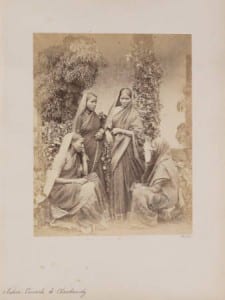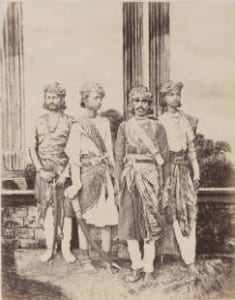This postcard by an unknown photographer shows a young Mexican woman standing alone beneath a tree. By nature of being a postcard, this image was intended to depict life in Mexico to the outside world. The woman is wearing a long dress with a floral print and a plaid shawl. The dress includes many details such as a floral pattern, ruffles near the hem, and a lace draping at the neckline. She is wearing lace-up shoes and carrying a basket with a woven floral motif. Her hair is pulled back in a braid or low bun, and shows off the earrings dangling next to her face. Her clothing would suggest that this is a special occasion or that she is going somewhere important like church or a wedding. As she leans against the tree she is looking down and smiling. She appears to be happy about something. She is carrying a basket but does not appear to be gathering anything. This image raises several questions like where is she going? Who is she and why is she so dressed up?
Native Converts to Christianity
This picture is “Native Converts to Christianity” by William Johnson taken in the 1850s or 1860s. This picture depicts four women, in a garden, seemingly discussing something in their religious garbs. It is important to note that this picture is clearly staged, as all four women are turned towards the camera with the picture able to capture the entire group. The photographer was obviously attempting to send a message to the viewer. All of the women’s heads are adorned with cloth, and their heads are tilted slightly downwards. On top of this, two women are sitting with the other two leaning against a hedge, showing a relaxed posture. Perhaps, this photographer wanted to demonstrate the oppression of women during this time period, based on their gestures, with their relaxed postures demonstrating the norm this oppression was. These women are composed and comfortable in their oppression, not knowing anything different in their lives.
http://digitalcollections.smu.edu/cdm/singleitem/collection/eaa/id/779/rec/87
Grinding corn in Tehuantepec
This picture is “Grinding Corn in Tehuantepec” by C.B. Waite in the year 1902. This picture depicts two young girls, working on some sort of mechanical device for corn, with one of the young girls holding a small infant. As both women are facing and looking at the camera, this picture was clearly staged by the photographer. This indicates that Waite had a message that he was attempting to portray through this photograph. The two young girls are clearly dirty, with manual labor the forefront of their plight. This demonstrates the working conditions and situation that young women had to face in Mexico in this time period. On top of this, the young woman holding the infant shows matriarchal symbolism in that a young woman is taking care of the infant, with the parents nowhere to be seen. This depicts the abandonment of young women in Mexico, not having the parental and monetary necessities and luxuries wealthy European or American children had at the time.
http://digitalcollections.smu.edu/cdm/ref/collection/mex/id/2574
On the Bhore Ghaut – Tunneling
This photo depicts the railway and the tunneling system used to connect different parts of India. These railways were essential in India for both the British and Indian people. Goods could move easier throughout India bolstering the economy, while at the same time allowing the British to transport goods from Northern India to their ports, and ultimately bring back to Europe. However, the most important aspect of the railways for the British was the ability to move troops and military resources throughout the country. Without this advantage the British may not have been able to keep complete control. The tunneling system used by the Indian people was extremely helpful for the British, yet seemed very dangerous to make, based on the fact that they had relatively primitive materials and experience especially with this new form of transportation.
The Metlac Bridge, Mexico
In Mexico the train industry, in addition to allowing the flow of goods, was essential in the spread of revolutionary ideas, as people could navigate the extensive countryside of Mexico and relate their beliefs and ideal image of Mexico. After the start of the Mexican Revolution, it also allowed for the movement of troops in order to suppress the uprising. Intricate bridge designs such as these were necessary in order to traverse the diverse topography of Mexico. The transportation of military goods across Mexico was necessary but often risked ambush from Mexican revolutionaries, as they were practiced in guerilla warfare because they were often outnumbered, thus required the element of surprise and stealth in order to keep up with their enemies.
The Old Vender
In 1902, C.B Waite took a photograph titled “Vender”. This photo shows an older man dressed in all white. Although he is small, the man is carrying a pile of merchandise larger than himself. He seems to be selling types of painted pots. Although hard to tell from the photo, it is possible that these pots are full of some type of substance. His clothing and occupation lead to the conclusion that the man was probably from a lower middle class household. Interestingly the old man seems to be standing in the middle of an agricultural field. Why is he selling his items there? Shouldn’t he be selling his goods to people in the city? Possibly the man is selling the pots as way for the farmers to obtain and drink water. Maybe the man works in the city and is being photographed as he walks back to the village he lives in.
http://digitalcollections.smu.edu/cdm/singleitem/collection/mex/id/2313/rec/161
Religious Discussion
“Native Converts to Christianity” is a photograph taken by William Johnson sometime between 1855 and 1862. The picture depicts four middle-aged women crowded around in a circle. These women are dressed in very plain clothing. That being said their saris do go down to the ground, which is typically a sign of wealth. This clothing mixed with the presence of very simple jewelry leads to the conclusion that these women most likely come from middle class families. This theory is supported by the gardens that they seem to be sitting in. The serious and focused looks that grace these women’s faces seem as if they are in the midst of a conversation or debate. I wonder what these women are talking about and why they look so serious. Drawing from the tittle of the photograph, I can guess that these women are talking about religion. This leads me to ask, are these women at a church? Is this how they dressed for church?
http://digitalcollections.smu.edu/cdm/singleitem/collection/eaa/id/779/rec/87
Rajput Mannequins

Alexander Leonard
Rajpoots by William Johnson, 1855
This photograph depicts 4 Rajput soldiers posing in their uniforms. The uniforms are a very ornate combination of cloths with no real armor or protection benefit. All 4 of them are also wearing a similar style head wrap. They all have lengthy hair; two of them have the same style mustache while the other two are completely shaven. Something that is interesting to note is that the two with moustaches have something on their feet while the other two have nothing. This could be indicative of some sort of seniority or superior status or rank. The weapon that all of them seem to be carrying is a long curved sword known as a Khanda. After closer inspection of their attire it’s also noticeable that they are all wearing a decent amount of jewelry on their ankles and neck. These men were perhaps very emblematic of the warriors of the Rajput at the time. They are proud, strong, clean looking soldiers. The pillars behind them may be indicative of the building they were defending. Pillars such as those usually belong to important, well-structured buildings. And the trees in the background show that they are not an in urban center, but perhaps in a rural location. The pillars and the trees give hints as to what they could be protecting. A temple perhaps? Were these troops commoners, or were they some elite guard?
http://digitalcollections.smu.edu/cdm/singleitem/collection/eaa/id/718/rec/13
Corn Grinders in Mexico

“Grinding corn in Tehuatpec” was photographed by C.B. Waite in 1902. In this photograph are 2 adolescent girls and a baby boy. One of the girls is grinding corn on a pedestal while the other is sitting and holding that baby boy, and both of the girls are looking at the camera. The girls are wearing simple clothing while the baby seems to be naked. On the pedestal is a bowl, and in the background there is a makeshift fence of small tree trunks. From this photograph it can be deduced that the family the girls are members of are poor because they have to help with chores. The family needs help, and the girls can both cook and watch the baby. The family also eats a lot of corn because they have a corn grinder that is well-used. Although it previously assumed that the girls are related, I do question if the girls are sisters, and that the baby is their brother. I also wonder where any adults are, like their parents.
http://digitalcollections.smu.edu/cdm/ref/collection/mex/id/2574
Working Bhundaree Women

“Bhundaree Women” was photographed by William Johnson sometime between 1855-1862. This photograph shows 3 Indian women during their daily lives. The two women on the left look younger than the woman on the right. These women have many coconuts with them, in baskets and scattered on the ground. The women are dressed in ragged and plain clothes. They are also sitting on the baskets or standing up and leaning against a tree trunk. From this photo it can be deduced that there women use the coconuts around them either for food, or to make a living, or both. All of the women seem to be poor, as they are dressed in ragged and plain clothes and they aren’t wearing much excess jewelry. After looking at this photograph, I wonder if the women are related, and if they are, how so? I also question why men aren’t in the photograph?
http://digitalcollections.smu.edu/cdm/ref/collection/eaa/id/747








